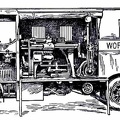At the beginning of 1909 there were two types of successful aeroplane—the Wright and the Voisin. Bleriot had flown with his monoplane and flown well; but he was still in the process of evolving a practical machine, and several other inventors were in a similar stage. It was the Wright and the Voisin which had proved their worth; and the Wright, as has been said, was the better of the two. Of the Voisin, as flown in 1909, a reproduction is given in the figure. It was a heavier aeroplane than the Wrights’, owing largely to the weight of its alighting gear (250 lbs.) and of its big balancing tail (more than 100 lbs.); hence the necessity for using a 50-h.p. motor, which drove a two-bladed metal propeller at the rate of 1200 revolutions a minute. The Voisin brothers, and other French makers, did not approve of the two-propeller system of the Wrights: they preferred one screw, revolving at high speed. But there was no doubt—at any rate in this stage of aviation—that the Wright method was more efficient than that of the Frenchmen. It was calculated, indeed, that the Wright biplane, when actually in the air, could be driven at an expenditure of only 15 h.p.; whereas the Voisin, even with its 50-h.p. motor running at full speed, had only just enough power to fly.
A. Elevating plane
B. Pilot’s seat
C.C. Main-planes
D. Engine and propeller
E. Landing chassis
F. Balancing tail
G. Rudder.
- Author
- The Project Gutenberg eBook, The Aeroplane, by Claude Grahame-White and Harry Harper
Published 1914 - Posted on
- Tuesday 18 August 2020
- Dimensions
- 750*297
- Tags
- Century:20th , Flight, Transport
- Albums
- Technology / Transport / Air
- Visits
- 1164
- Downloads
- 36
 Download Photo
Download Photo





